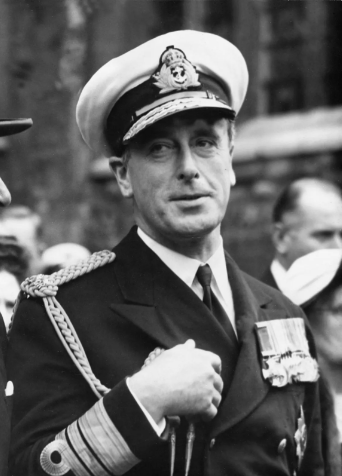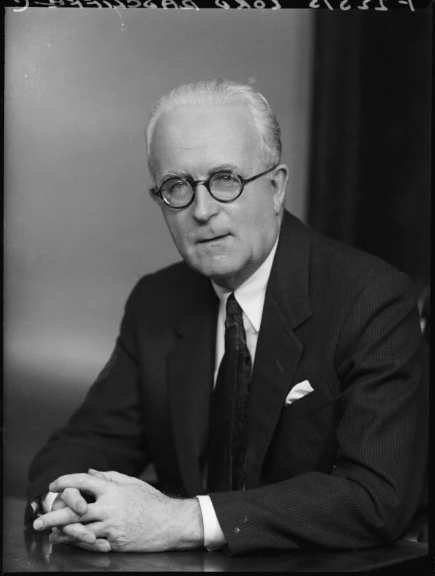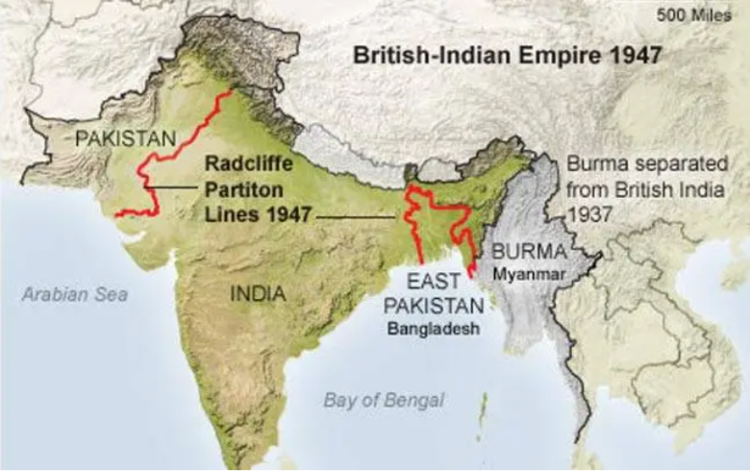The chairman of the Radcliffe Boundary Commission told veteran Indian journalist Kuldip Nayar, “I nearly gave you (India) Lahore. But then I realised that Pakistan would not have any large city. I had already earmarked Calcutta for India.”
Shocked? You ought to be! If this was the arbitrary way in which the Partition was done, the bloodshed that followed was but an eventuality.
When it was decided to grant India the long-due Independence, Great Britain parachuted two people one after another into India.
Lord Louis Francis Albert Victor (“Dickie”) Mountbatten – the flamboyant cousin of King George VI – arrived in March 1947 as the last Viceroy. Lord Louis Mountbatten oversaw the Partition of British India into India and Pakistan. The BBC documentary “Partition: The Day India Burned” states that his brief from the British government was simple: “Get a deal and get Britain out before India imploded!” Much like what one saw the AU and allies do in Afghanistan about two years ago.
On 8th June 1947, Lord Cyril Radcliffe, a retired judge whose integrity and honesty seemed beyond doubt to his country’s government, was stepping on Indian soil for the first time. And so was Lord Louis Mountbatten. Neither knew India well, and had not the faintest idea of its rich history, conflicts, and problems.
Albert Victor Nicholas Louis Francis Mountbatten, 1st Earl Mountbatten of Burma:
When the British Parliament and the monarch sent Mountbatten – the great-grandson of Queen Victoria – the first Empress of British India, the mandate was that he had up to June 1947 to complete his mission.
But Mountbatten was a man in a hurry. He decided to complete the task in a jiffy and head back home to Britain to advance his own naval career. Therefore, he decided to bring forward the date by 10 months to coincide with another similar date in the year 1945 when as the Supreme Allied Commander South East Asia Command in World War II, he oversaw the recapture of Burma and Singapore from the Japanese in 1945.

Stanley Wolpert, in his book “Shameful Flight: The last years of the British Empire in India” writes about the mayhem that followed Britain’s decision to divest itself from the crown jewel of its empire. He cites how Britain’s precipitous and ill-planned disengagement from India in 1947 was condemned as a “shameful flight” by Winston Churchill.
This haphazard partition of a great and ancient nation had a truly catastrophic effect on South Asia, leaving over a million people dead in its wake and creating a legacy of chaos, hatred, and war that has lasted over 75 years. Wolpert places the blame for the catastrophe largely on Mountbatten who rushed the process of nationhood along at an absurd pace.
“The viceroy’s worst blunder was the impetuous drawing of new border lines through the middle of Punjab and Bengal. Virtually everyone involved advised Mountbatten that to partition those provinces was a calamitous mistake that would unleash uncontrollable violence,” writes Wolpert.
It is well known that when the new boundary lines were announced, arson, murder, and mayhem erupted with the Hindus-Sikhs fleeing Pakistan attacked, killed, raped, looted, and kidnapped by the Muslims who then were free to grab the emptied houses and land. There was a retaliatory attack by the Hindus who were infuriated by the train-loads of dead bodies of Hindus that were arriving in trains from Pakistan.
In the BBC documentary “Partition: The Day India Burned” the Mountbattens’ youngest daughter Lady Pamela Hicks moved into the Viceroy House (now Rashtrapati Bhavan) with a staff of 5,000 at beck and call. She tells of how Jinnah played it cold and aloof with Mountbatten while Nehru got along with the Mountbatten couple like a house on fire. “My God, is Jinnah cold!” is what Mountbatten said after the negotiations talk involving Nehru and Jinnah.
Narendra Singh Singh Sarila who was ADC or an aide to Mountbatten told BBC that despite being the cousin of the king, Mountbatten was a man without airs, and that endeared him to the Indians. Pamela Hicks argues her father did not hurry up the pace because it was already too late. Yet, as per Sarila’s interview, Mountbatten did have time for tiger hunts.
“Partition uprooted over ten million people, 500,000 to a million of whom died in the ensuing inferno. Here then is the dramatic story of a truly pivotal moment in the history of India, Pakistan, and Britain, an event that ignited fires of continuing political unrest that still burn in South Asia,” writes Wolpert.
And was Mountbatten remorseful, or apologetic about his grave folly and selfishness? British Library oral archives have an interview of Lord Mountbatten from 1976 where Charles Allen asks him about Mountbatten’s role in the Partition. Mountbatten says that he did not favour a particular side (neither India nor Pakistan), although he noted that Jawaharlal Nehru, president of the Indian National Congress, was easier to deal with than Muhammad Ali Jinnah, leader of the All-India Muslim League.
Sir Cyril John Radcliffe:
This man was to become the ultimate villain of the piece.
Sir Cyril Radcliffe who drew the Partition map that carved Pakistan out of India knew nothing about India.
Sent to the Viceroy’s Lodge in Shimla to work in peace, Cyril John Radcliffe, also decorated as the 1st Viscount Radcliffe – a British lawyer and retired judge, was given the onerous task to etch the borders of the two states that were to emerge after partitioning India into India and Pakistan.
After submitting the finalised partition drawing – called the Radcliffe Award – on 17 August 1947, he left India, never to return till his dying day. Radcliffe died on 1 April 1977.

He was given 5 weeks to finish the Partition work. Census work in 1941 had suffered due to World War II and Radcliffe had the 1931 Census at hand. He consulted the outdated Census records and maps because the British could not get a fresh survey done in the June heat of the tropical nation they had ruled so long.
Radcliffe submitted the partition map on 9 August, which was passed on 12th August but declared in its details, only on 17 August, a good two days after Independence Day.
How Lahore was cheated and millions died:
With East Bengal already going to Pakistan and the word going around that Lahore was to remain with India, people in Lahore were complacent. VK Malhotra, veteran BJP leader and RSS veteran who was in his hometown Lahore when the Partition mayhem broke out tells how the Hindus and Sikhs of Lahore realised that Lahore was going to Pakistan only when the Congressmen began leaving the city on the quiet with their own families. Malhotra tells how Hindu and Sikh girls were abducted by Muslim residents and thousands of them remained untraced as it was a civil war-like situation. RSS volunteers were running a shelter camp for the displaced Hindus, with doctors, and nurses on duty round the clock. Daily 5-5 RSS Swayam Sevaks would get into jeeps to rescue Sikhs and Hindus from various areas such as Gawalmandi, Mewamandi, Kila Gujar Singh, etc,
Veteran journalist Kuldeep Nayar interviewed Radcliffe in London in 1976, the latter said, “I nearly gave you (India) Lahore. But then I realised that Pakistan would not have any large city. I had already earmarked Calcutta for India.” How could Radcliffe consider Dhaka (Dacca) or Karachi that Pakistan got by default as any smaller city?
Was he remorseful? Did he regret his hastily done job? “I had no alternative; the time at my disposal was so short that I could not do a better job. Given the same period, I would do the same thing. However, if I had two to three years, I might have improved on what I did,’ adding, ‘if aspirations of some people had not been fulfilled the fault must be found in political arrangements with which I am not concerned,” Radcliffe told Nayar.
His friend Robert Armstrong defends his British Barrister friend Radcliffe who had never been east of Paris before he was parachuted into India. He was a remarkable man. He had an unerring gift of going to the heart of whatever he was doing. He was a very rational man… and did not think of Mountbatten as a man to be relied upon… though he did not dislike the last viceroy of India… It was the loneliness of the decisionmaking, he had to make a series of decisions on the boundary issue all by himself – alone.”
Artist Satish Gujral who was a student in Lahore then told BBC that all his college friends were sure Lahore was to go to the Indian side because everything belongs to Hindus: education, money, banks, insurance buildings, businesses.
Lahore – the ancient city of Lavapuri (the city of Lord Ram’s son Luv) (his twin brother, Kush, having founded the twin city, known today as Kasur) is a city that was built by the economic fortunes of the mercantile Hindu-Sikh community and a professional class of Hindu-Sikh doctors, engineers, educationists. It is the city that was built by Sir Ganga Ram and where Bhagat Singh was hanged to death for working towards India’s Independence. Lahore was the city where Lala Lajpat Rai led the “Go Back, Simon” protests. This was the capital city of the erstwhile Sikh empire of Maharaja Ranjit Singh. This was the place that nurtured the Arya Samaj movement of reforms in Hinduism. According to the 1941 Census, the Hindu-Sikh population of Lahore was nearly 40 percent and they owned 80 percent of the businesses in the city.
Today’s Lahore has stamped out every bit of its Hindu identity and is brazenly only Islamist. Yet the monuments built by the Hindu citizens remain. The Sir Ganga Ram Hospital for one.
Celebrated poet WH Auden, in his work “Partition” sums up Radcliffe’s helplessness, the onerous task he was given, and its horrific consequences:
“… But in seven weeks it was done, the frontiers decided,
A continent for better or worse divided.
The next day he sailed for England, where he quickly forgot
The case, as a good lawyer must. Return he would not,
Afraid, as he told his Club, that he might get shot.”
Radcliffe went away to England immediately after his work was submitted. He heard of the mayhem later and is said to have refused to accept the 3000 GBP or Rs 40,000 in fees that he was supposed to be paid for the job. He also never returned to India, or for that reason, even Pakistan. He died on 1 April 1977.



















Comments